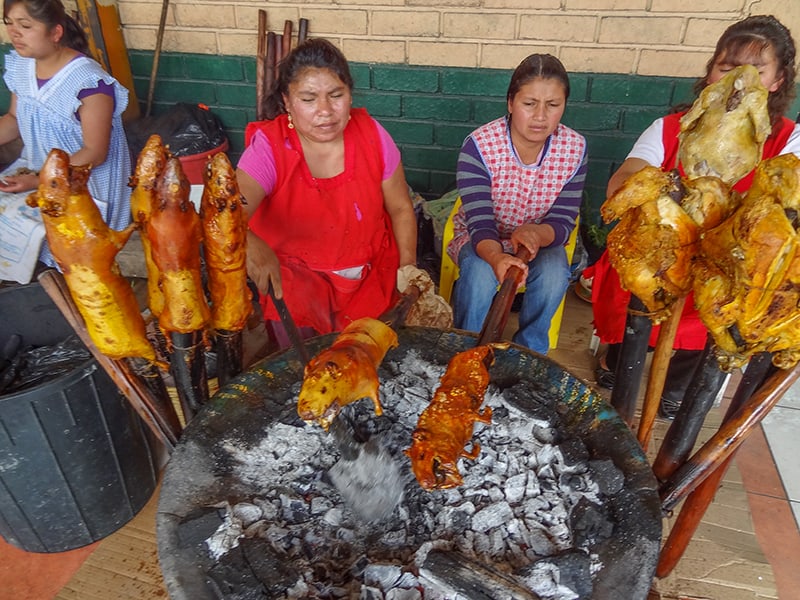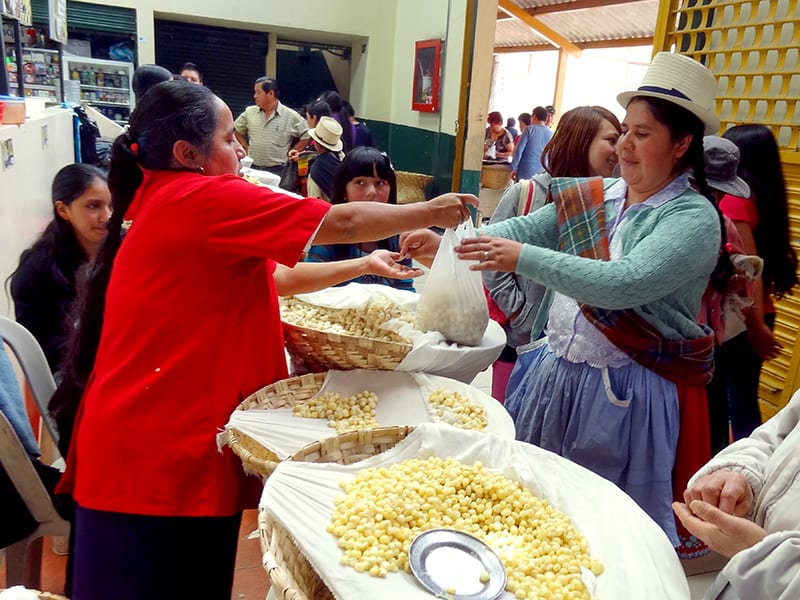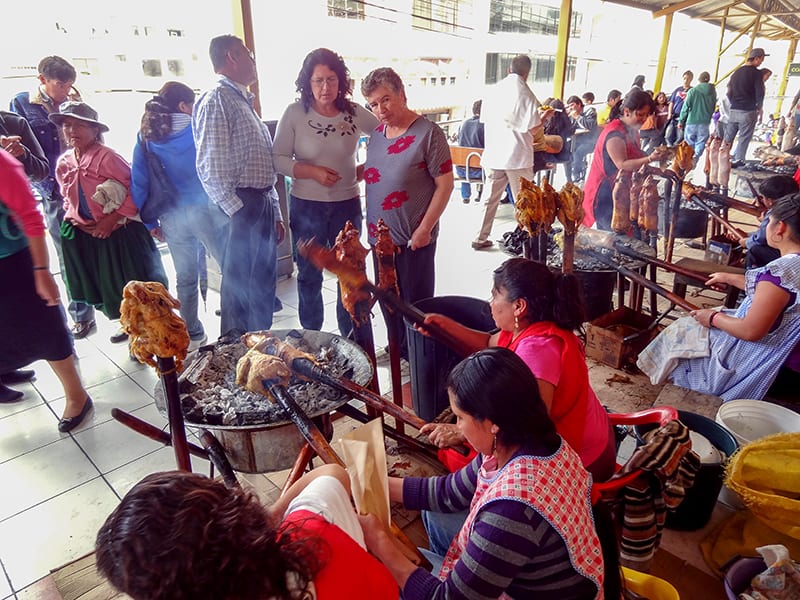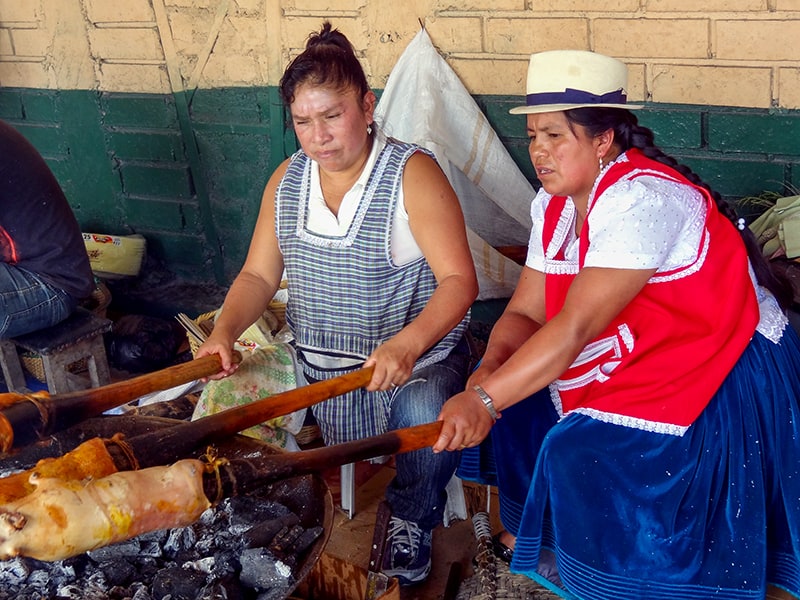Last Updated on August 2, 2024

Estimated reading time: 5 minutes
I’m not an adventurous eater, by any stretch of the imagination. But then I went to Ecuador, where eating guinea pig is very popular. I knew I had to take the leap…
By Jim Ferri
Eating guinea pig is something people enjoy in various countries of the world. One of them is Ecuador.
I’ll admit that when comes to food, I’m not adventurous. That crown goes to my wife Marjorie, who believes that the hotter and spicier something is, all the better. From my perspective, pepper pushes the culinary envelope far enough.
A few days ago in Ecuador, though, the tables turned. We were in Cuenca, high up in the Andes, spending a few days in that magnificent city. With our guide Cecilia we were roaming about the town’s outdoor market.
It was an interesting place filled with many of the indigenous people. Their heads topped with the Panama hats, they were selling all sorts of foods and vegetables. (By the way, Panama hats are actually made in Ecuador. They were misnamed long ago because they were shipped out of Panama.)

Wandering About the Market
We wandered about the market for about an hour, and I wondered if I’d see anyone eating guinea pig. We continued walking, fascinated not only by bustle and riot of color all about us, but also by several types of vegetables we’d never seen before. It was a great way to spend the morning, much better than our visit to the market in Otavalo, which is a tourist trap. Cuenca’s market though, was the real thing. In fact, I don’t remember seeing more than two or three other foreigners in the whole place.
After the three of us had wandered down just about every little lane ogling the produce and the people, Cecilia asked us if we wanted to see the meat market. It was also where you can see locals eating guinea pig.
“Of course,” we replied, and followed her out of the open marketplace. The meat market is two blocks away she explained, because of the need to separate the butchers from the produce for sanitary reasons.
A Hive of Activity
It looked like a quiet building from the outside, but when we stepped inside we found a hive of activity. Picnic-type tables set up around the periphery, all filled with people eating. The place itself ocupies two floors. We followed Cecilia up to the second floor, which turned out to be a balcony that looked down upon the butchers below.
Around this balcony, though, were dozens of little stalls each with a woman serving slices of the giant pigs (the Porky kind) on spits, along with a side of fried potato pancakes. After one of the women gave us a taste, it was apparent that fatty pork was a popular local dish.
When we wandered back down and outside we came upon a line of women sitting about large round charcoal grills. Each had the circumference of a large oil drum. Over them, chickens and guinea pigs were slow-roasting on large wooden stakes. At several small tables people were eating guinea pig.

Guinea Pigs Galore
These weren’t the small guinea pigs kids keep in cages in their bedrooms either, but monsters as large as a fair-size cat. Cecilia told us it was a local delicacy and each took about an hour to cook.
Although it was totally out of character for me, I asked Cecilia if we could try one. I glanced over and saw the look of horror on my wife’s face. “You’re not really going to try that, are you?” She asked. I told her that I heard about these and that I couldn’t leave Ecuador without at least trying one. I though she would faint.
It cost us eight dollars – – the US dollar is the legal currency of Ecuador – – and we took our little prize to one of the picnic tables. We are dismayed that the head hadn’t been taken off as we had requested, but we proceed with our taste test nonetheless.

You Don’t Find a Lot of Meat While You’re Eating Guinea Pig
Cecilia dove in first, showing us how to do it all. When I took my turn at eating the guinea pig I saw it was red meat, not white. And it surprised me as to how little meat there actually was. It was almost like trying to get meat off a Cornish hen.
More surprising was that it tasted like a cross between chicken and pork without being as greasy as what we had tasted earlier upstairs.
Alongside most of the tables sat a line of small, cute dogs that just stared at you, with no barking or growling or nudging you for handouts. They fascinated me, since when you tossed a piece there was no scramble to take it away from another, they all just sat there patiently and quietly waiting their turn.
I’m certain when we left, taking the other half of the meal to our driver, they were unhappy. Marjorie, on the other hand, was pleased to be moving on to sightseeing elsewhere.
You may also enjoy: Things to Do in Cuenca, the Magical City in the Andes / Top Places To See in Ecuador / A Guide to A Galapagos Cruise Vacation

Just so we are clear, it was not the head that bothered me, but the claws (with nails). Also, it is as fatty as the large pigs we saw. But kudos to Jim for being the adventurous one in this case. In my defense, I did try the potato patties.
Ask Jim about the aji that they serve with each meal in Ecuador!
I am from Ecuador and the Cuy (guinea pig) is a delicacy in the ecuadorian Sierra. Not in the pacific ecuadorian coast. Yes, the cuy doesn’t have a lot meat like a piece of chicken. But the taste of the cuy’s meat is delicious and unique. You have to eat its skin and chew the bones, there is the real cuy’s taste. You mention the meat was red not white. Traditionally the cuy is marinated with achiote which is an ancient aborigen red coloring condiment muy popular in some South American countries, I might say Ecuador, Perù, Bolivia. Also, the cuy is marinated with a lot whole cumin which is placed inside of the cuy like stuffing and of course salt is generously use to marinate the cuy. Usually, the cuy’s body meat is white and the thighs and legs are kind of dark meat. After this pandemic is kind of over, I am looking forward to travel to my native Ecuador to eat cuy like a king. Really, really the cuy is delicious!
Thank you Ancieto. Bon Appetit!
Hope you are having a good time visiting my home country and taking good care of yourselves. Don’t be afraid to try the food specially the ones served in the markets like you visited in Cuenca. The women with the Panama hats that sell the products put a lot of effort to get them from the country side to the city. Have a great time over there. Don’t forget to drink a shot of zhumir. They said is for you no to get sick and is strong but very good.
Nice!
Thank you. I’m glad you liked it Zairy.
Jim
Hello, I am from the Coast of Ecuador and cuy is not part of our diet. I honestly cannot pass the fact of its similarity to a rat without a tail in those pinchos… silly yes possibly. Because each time I go to Cuenca’s food market I eat pork, which presentation is with kind of similar (head and feet on) and it’s delicious. All about what area in Ecuador you are. So I should be clear that “Cuy” is a delicacy in the Sierra of Ecuador.
Thank you Natalia. I always enjoy it when readers give me information like you have.
Jim
Very nice article. I am from Cuenca I used to eat cuy when I was younger. Not anymore we don’t eat any kind o meat that’s why.
The markets in Cuenca are amazing full of colors from fruits and vegetables.
Thank you for sharing your experience in my City.
Hi Rosa,
I’m glad you enjoyed it.
Jim
Buen artículo.
Lo más rico del planeta “ cuy asado”
Los sombreros de “ Panama “ siempre por siempre ancestrales se han hecho en Ecuador. Habría que leer la historia. Saludos y abrazos.
Viva Cuenca !!
Muchos gracias Elsa,
Viva Cuenca !!
Jim